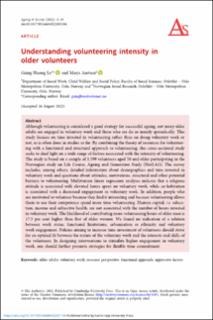| dc.description.abstract | Although volunteering is considered a good strategy for successful ageing, not many older adults are engaged in voluntary work and those who are do so mainly sporadically. This study focuses on time invested in volunteering rather than on doing voluntary work or not, as is often done in studies so far. By combining the theory of resources for volunteering with a functional and structural approach to volunteering, this cross-sectional study seeks to shed light on a wide range of factors associated with the intensity of volunteering. The study is based on a sample of 1,599 volunteers aged 50 and older participating in the Norwegian study on Life Course, Ageing and Generation Study (NorLAG). The survey includes, among others, detailed information about demographics and time invested in voluntary work and questions about attitudes, motivations, structural and other potential barriers to volunteering. Multivariate linear regression analyses indicate that a religious attitude is associated with elevated hours spent on voluntary work, while co-habitation is associated with a decreased engagement in voluntary work. In addition, people who are motivated to volunteer because they find it interesting and because volunteering allows them to use their competence spend more time volunteering. Human capital, i.e. education, income and subjective health, are not associated with the number of hours invested in voluntary work. The likelihood of contributing more volunteering hours of older men is 17.5 per cent higher than that of older women. We found no indication of a relation between work status, functional limitations, urbanisation or ethnicity and voluntary work engagement. Policies aiming to increase time investment of volunteers should strive for an optimal fit between the nature of the voluntary work and the interests and skills of the volunteers. In designing interventions to stimulate higher engagement in voluntary work, one should further promote strategies for flexible time commitment. | en_US |

